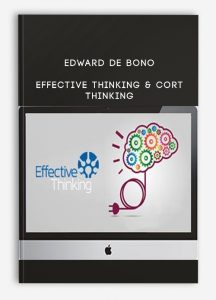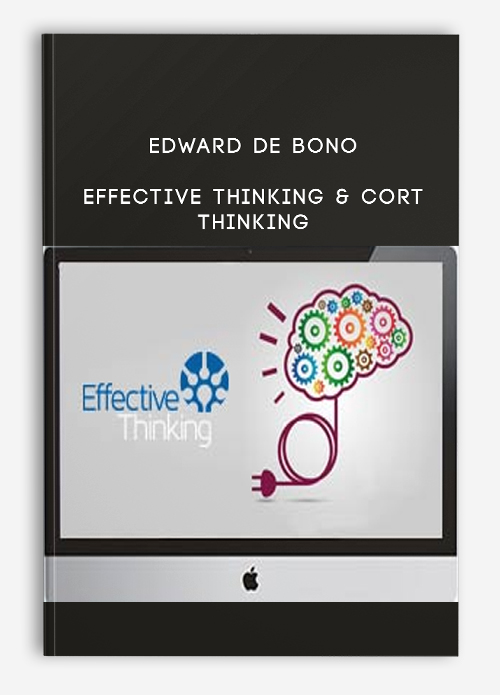Subtotal: $87.00
Edward De Bono – Effective Thinking & CoRT Thinking
$1,524.00 $89.00

Edward De Bono – Effective Thinking & CoRT Thinking

Archive : Edward De Bono – Effective Thinking & CoRT Thinking
A course designed to change the way you think.
3 Modules
The first module covers de Bono’s thinking Tools, then module 2 considers various thinking situations before going on to explore creativity and lateral thinking in module 3.
36 Hour Course
On average the course takes 36 hours to complete. If you do a lesson a day it will take you 24 days, or a lesson every week will take you 24 weeks.
219 Thinking Exercises
Dr de Bono’s thinking exercises will train your brain in the thinking tools and creativity techniques. Challenging you to make the changes needed for you to achieve better thinking outcomes.
Online eLearning
Study whenever you want, wherever you want. Our course is available 24 hours a day. Giving you the time to really engage and reflect on the learning.
de Bono Certified
Your thinking exercises will be assessed by your tutor and if you make the grade you will awarded the de Bono Effective Thinker certification.
de Bono Tutors
The Effective Thinking Course is administered by two Master Tutors that have been personally trained and certified by Dr. Edward de Bono.
Get Edward De Bono – Effective Thinking & CoRT Thinking on Tradersoffer.com
Dr Edward de Bono – The inventor of Lateral Thinking.
Dr de Bono is widely regarded as the world’s leading authority on the teaching of thinking as a skill.
The creator of ‘Lateral Thinking’ and best-selling author of over 80 books. Edward de Bono’s training and thinking methods have been used around the world. Dr de Bono has held faculty Professorships at Harvard, Oxford and Cambridge Universities.
- Dr. de Bono has lectured in 61 countries.
- He was a former Rhodes Scholar.
- A MA.in Psychology and Physiology from Oxford.
- A D. Phil. from Cambridge University.
- Nominated for the Nobel Prize for Economics in 2005.
- EU ambassador for Creativity & Innovation
“I created this course based on thirty years’ experience teaching thinking to thousands of adults and children around the world. The thinking tools are deliberate and can be used systematically. They are easy to use and powerful”
You are introduced to the thinking tools and techniques which have proven to increase abilities in areas such as creativity, problem solving and critical thinking. As you move through the course you will encounter material and assessments that are designed to cement these concepts into your mind. This first module consists of the following 8 lessons.
1: Are you a thinker? Looks at the students self-image as a thinker and at thinking skills in General. Setting the stage for your journey towards Effective Thinking.
2: PMI – Plus, Minus and Interesting Analysis of Plus, Minus and Interesting points. This is a powerful tool for considering new ideas.
3: AGO – Aims, Goals and Objectives The examination of Aims, Goals and Objectives. An AGO is used to clarify thinking.
4: Consider all Factors This involves a structured process to the Consideration of All Factors. It is often used when considering situations prior to developing ideas.
5: OPV – Other People’s Views Almost any thinking activity involves other people, the OPV tries to get the thinker inside the heads of those involved.
6: FIP – First Important Priorities The FIP provides a deliberate instruction to you (or to others) to focus directly on priorities (in general or at a particular moment).
7: APC – Alternatives. Possibilities and Choices The APC lesson involves looking for the Alternatives, Possibilities or Choices (whichever is appropriate) in that situation.
8: C&S – Consequence and Sequel This is a scan of time for your brain. Helping you focus upon the consequences that might arise from a decision, course of action or change of any sort over time periods.
Building on the tools learned in the previous module the participant explores the different types of thinking situations that exist and how you should proactively react to them. By understanding the type of problems you face you can learn the thinking skills to develop better solutions.
1: Plan and action Thinking is involved not only in arriving at a decision but also in carrying it out. Planning is usually an essential part of getting something done.
2: Decision and evaluation Judging the value of an option. Is this worth doing? Making decisions and making choices.
3: Problem-solving and design Finding solutions to problems, and designing solutions to problems. In a sense any design task is also a problem-solving task.
4: Coping and organising: Coping with confusion and mess. Creating order out of chaos. Organising different elements so that the whole works – a common enough real life situation.
5: Negotiation and conflict Two party situations often have each side trying to get what they want. This lesson will help you turn arguments and conflict into win-win outcomes.
6: Communication and persuasion The transfer of information. The transfer of perceptions. Clarity of communication. Opening up perceptions in persuasion.
7: Exploration and discussion Making a map of the situation. Getting as much information as possible. Discussion with the purpose of exploring a situation.
8: Opportunity and initiative Much of our thinking is reactive: we are forced to think about something. In this Section we look at initiatives: we set out to think about something because we want to.
You will focus on creativity and lateral thinking. Learning to think outside the box is important when you need to problem solve. You should be able to recognise situations that need some extra creativity and brainstorm in an effective focused manner that delivers results. The Creativity and Lateral Thinking module consists of the following 8 lessons.
1: The need for lateral thinking Realising the need to improve the quality of our thinking. Application of thinking to different areas.
2: Basic level creativity The cure for arrogance and the deliberate search for alternatives: concepts and explorations. The mechanics of new routes.
3: Judgement and movement The difference between perception and processing. Patterning systems, and the concept of idiom. humour, logic and lateral thinking.
4: Escape Escape from your train of thought.. learn to take a different road.
5: Stepping stone Learn to look for the way forward a step at a time. Every creative journey starts with a step.
6: Random juxtaposition Unleash the power of your mind with this technique when you need them.
7: The treatment of ideas Constraints, shaping, using and harvesting ideas.
8 : Focus How to define the creative thrust. The creation of idea sensitive areas for the generation of creative thinking.
Get Edward De Bono – Effective Thinking & CoRT Thinking on Tradersoffer.com
Edward De Bono – Effective Thinking & CoRT Thinking Download, Effective Thinking & CoRT Thinking Download, Effective Thinking & CoRT Thinking Groupbuy, Effective Thinking & CoRT Thinking Free, Effective Thinking & CoRT Thinking Torrent, Effective Thinking & CoRT Thinking Course Download, Edward De Bono – Effective Thinking & CoRT Thinking Review, Effective Thinking & CoRT Thinking Review
Internet Marketing Course
Digital marketing is the component of marketing that utilizes internet and online based digital technologies such as desktop computers,
mobile phones and other digital media and platforms to promote products and services. Its development during the 1990s and 2000s,
changed the way brands and businesses use technology for marketing. As digital platforms became increasingly incorporated into marketing plans and everyday life,
and as people increasingly use digital devices instead of visiting physical shops, digital marketing campaigns have become prevalent,
employing combinations of search engine optimization (SEO), search engine marketing (SEM), content marketing, influencer marketing, content automation,
campaign marketing, data-driven marketing, e-commerce marketing, social media marketing, social media optimization, e-mail direct marketing, display advertising,
e–books, and optical disks and games have become commonplace. Digital marketing extends to non-Internet channels that provide digital media, such as television,
mobile phones (SMS and MMS), callback, and on-hold mobile ring tones. The extension to non-Internet channels differentiates digital marketing from online marketing.
More Course: INTERNET MARKETING
Outstanding Course: https://tradersoffer.forex/product/war-room-trading-academy-millionaire-founders-edition-by-andrew-tate/
Be the first to review “Edward De Bono – Effective Thinking & CoRT Thinking” Cancel reply
Related products
Internet Marketing Courses
Internet Marketing Courses
Internet Marketing Courses
Internet Marketing Courses
Internet Marketing Courses

 Best Seller Publishing from Rob Kosberg
Best Seller Publishing from Rob Kosberg 








Reviews
There are no reviews yet.